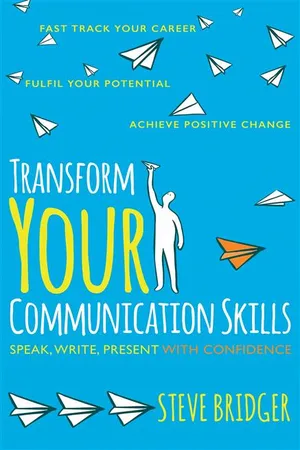![]()
![]()
5
BUILDING CONFIDENCE AND OVERCOMING SHYNESS
Would you rather walk the plank than speak in front of an audience?
This is not as crazy as it sounds. The very idea of speaking to a group of people and being in the spotlight is to many a fate worse than death. In Chapter 5, I’m handing over to Steve Engwell, who will explain ways to overcome shyness and provide a visualisation exercise you can practise to ease negative feelings and help prepare to speak in a business or public setting.
Steve Engwell – NLP Master Practitioner
“Our beliefs are the stories we tell ourselves. Change the story to change the belief”
What is NLP?
NLP, or Neuro Linguistic Programming, was created by Richard Bandler and John Grinder in California, USA during the 1970s. They studied human excellence and were curious about ‘the difference that made the difference’ between people who were good at what they did and those who were excellent.
NLP is a model of communication. It focuses on how we individually think about our values and beliefs and how this in turn creates the emotional states, behaviour and identity for our inner world, which then manifests externally. It’s about the language of the mind using pictures, sounds, feelings, taste, smell, and self-talk. We are what we think and feel.
Our behaviour has a structure and this can be modelled (that’s both our conscious and unconscious patterns), learned (like a strategy being run) and changed (re-programmed). Excellent behaviour can be duplicated. NLP can be described as:
N – Neurology. How our brain and physiology is wired up harmoniously together to allow us to breathe, laugh, walk, eat, learn habits and to feel as we do.
L – Linguistic. The verbal and non-verbal language we use when we talk to ourselves (like stories we tell ourselves) and communicate with other people.
P – Programming. The bringing together and combining of all the above patterns to create our own unique software that we run automatically, just like a computer program to achieve the results we do – good and bad.
Put simply, NLP is a set of tools and approaches that modify patterns of thinking that affect the way we behave. Change the way you think and you change the way you feel and act. Doing this will build confidence and help you overcome shyness in every aspect of your life.
Overcoming Shyness or a Lack of Confidence
Did you know that we are born with only two fears – the fear of falling and the fear of loud noises?
These are said to be built into our DNA and have been passed down through the generations as a survival mechanism for ‘fight’ or ‘flight’. Their sole purpose is to keep you alive and create emotion that will motivate you to move away from danger.
Did you know therefore that any other fears that we subsequently exhibit are learned behaviours and they are quite often picked up in our very early formative years? This has often been described as an innate form of learning from situations, circumstances and from typically influential authority figures around you as you grow up, e.g. parents, guardians, teachers, etc.
Did you know that if this behaviour was learned behaviour, then it can be unlearned?
Can you begin to imagine the sense of freedom as you throw off those shackles to tackle what were once perceived as your greatest fears and inhibitions and move forward to transform your life? The good news is that this can be achieved with true commitment and determination to change.
For many people the mere thought of stepping out into a group to deliver a presentation, to give a talk or conduct a seminar can bring back familiar feelings of dread, emotional anxiety and a sinking feeling in the pit of their stomach. Unfortunately this situation can then become compounded by unnecessarily negative self-talk which only goes to reinforces the fear. But where did these negative feelings and emotions come from? What events in earlier life created such a powerful trigger, sufficient to paralyse you, sabotage your future and spoil your enjoyment of life?
Are you really going to want to give up your dreams or should you aim to get rid of those pesky annoyances? These old perceptions can sometimes be described as faulty programming in our brains and are likely to remain with us until they are addressed and corrected. As you grow older, why would you bother to listen to that inner, inexperienced voice of the child? You are now a mature adult who has been part of some wonderful life experiences. To change is to face the fear, lock away those old beliefs that are no longer the true you, drop that baggage and enjoy life’s opportunities.
“If one advances confidently in the direction of his dreams, and endeavours to live the life he has imagined, he will meet with a success unexpected in common hours.”
Henry David Thoreau (author, poet, philosopher)
It can be difficult to look back and pinpoint when specific fears started or where they emanated from, however, there is likely to have been a situation during the early part of your life that created a misconception at that time, leading to some faulty programming that manifests itself as a ‘limiting belief’. Such fears are often quite irrational and make no real sense to justify why you would allow them to rule you during adulthood. It is worth noting that these are indeed ‘beliefs’ and not ‘truths’ as they are something you have chosen to acknowledge and believe to be true.
At this point you may already be reflecting on your own perceived inhibitions and it’s good that you should bring these to mind now in readiness to let them go forever. It is time to update any faulty programming, clear and reformat the hard drive to reinstall a new, up-to-date operating system that could be the Windows on your new life.
The Conscious and Unconscious Mind
We all have a conscious mind and we also have an unconscious mind. The unconscious mind stores and organises your memories, but its primary job is to protect you at all times and it will always function for the highest possible intent. Although we process some 2 million pieces of information every second, consciously we may only be aware of 7, plus or minus 2 bits of information, which means a number between 5 and 9 (George A Miller 1956). Our awareness is highly selective. For example, until I mention it now you may not be aware of the tip of your left ear, the floor beneath your feet or your back pressing against the chair. By directing your attention you will have brought these back into consciousness – they were always there but are now part of those 7 (+ or – 2) pieces of information. As human beings we generalise, distort and delete information all the time to free our attention and make the whole thing more manageable.
These limiting old beliefs are stored as memories in our unconscious minds and it becomes a question of accessing them to change them. There are a number of possible ways to begin to address this issue so that behaviour and habits can be changed and ‘unlearned’. The irrational fear or belief that you hold is likely to have served you in a positive way at some time in the past.
Take young, shy Johnny, who at the age of 5 was asked to come to the front of the classroom to read from a book. Johnny blushes, he has not done this before, and walks out to a sea of faces; he turns to the class, which falls silent, lifts the book and proceeds to read aloud, his nerves making him stutter:
Johnny: “Eeerrrr… Eric had always wwww… wwwwanted a pppp pppppeeett pet of his own. A cccc… cccccc… aa… ccc… aaaatt cat. Eerrriiicc thought aaa aaas as he… ”
Teacher: “Thank you, Johnny, that’s fine, you can now sit down”.
Phew, what a relief for Johnny, that was over quickly. He thinks, “I don’t have to read any more to the class today. Job done. Thank you unconscious mind!” And yet, in that very moment a limiting belief was created. The mere act of stammering nervously in front of the teacher quickly got Johnny out of the situation. The unconscious mind can now run a process that can be used to ‘protect’ that child and can run this process at any time, to spare his anxiety, just like a computer programme.
But when Johnny reaches the age of 22 he is asked to give a presentation in his new job to the Board. In this analogy, Johnny needs a new self-image – would others really want to listen to, observe and emulate the actions of a five-year-old? No… that would be ridiculous, wouldn’t it?
The issue isn’t th...




